By Sam Glaser
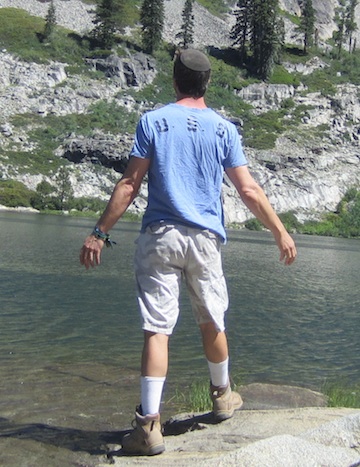 I am both a music lover and music maker. I’ve learned that the two are mutually exclusive; I have composer friends that minimize exposure to anyone else’s music in order to avoid being unduly influenced. I, on the other hand, regularly thank God for the gift of listening to music…any kind of music! Particularly when driving in LA traffic jams. I’m a fan of many local, US and international bands and I try to be a good groupie and sit in the front row whenever I can sneak out to their shows. I’m a regular at the LA Phil and LA Opera. I’m obsessed with jazz. I have over 3000 CDs of all genres in my collection and I still have my ear out for new sounds. My wife and I share in the Top 40 fun with our three kids and keep abreast of The Voice, Idol and America’s Got Talent. We admit to being both Beliebers and Gleeks. I used to brag that I like every style of music except Country. Well, thanks to dedicated honky-tonk friends I have been converted to the best of southern pedal steel, hillbilly, bluegrass, gospel and even yodeling.
I am both a music lover and music maker. I’ve learned that the two are mutually exclusive; I have composer friends that minimize exposure to anyone else’s music in order to avoid being unduly influenced. I, on the other hand, regularly thank God for the gift of listening to music…any kind of music! Particularly when driving in LA traffic jams. I’m a fan of many local, US and international bands and I try to be a good groupie and sit in the front row whenever I can sneak out to their shows. I’m a regular at the LA Phil and LA Opera. I’m obsessed with jazz. I have over 3000 CDs of all genres in my collection and I still have my ear out for new sounds. My wife and I share in the Top 40 fun with our three kids and keep abreast of The Voice, Idol and America’s Got Talent. We admit to being both Beliebers and Gleeks. I used to brag that I like every style of music except Country. Well, thanks to dedicated honky-tonk friends I have been converted to the best of southern pedal steel, hillbilly, bluegrass, gospel and even yodeling.
I made another music discovery recently. It’s called the High Sierra Music Festival and I am convinced it is the ultimate musical indulgence on the planet. Sports fans have the World Series and the Final Four. For us music lovers, High Sierra is the Holy Grail. I’ve been to other festivals before, usually a single epic day of rock, R&B or jazz from which I return home with a smile on my lips and my ears ringing. But this High Sierra Festival is a binge of another dimension: a captive audience of 10,000 fans camp together at the Quincy Fairgrounds for four days with over fifty top-notch bands. Curated by someone who REALLY knows quality music. If there is any common denominator between the featured acts it’s a proven track record, years on the road, virtuoso musicianship, fun, upbeat tunes and a multi-genre sensibility with the ability to switch easily while keeping the groove intact. No Top 40 or Tribute Bands need
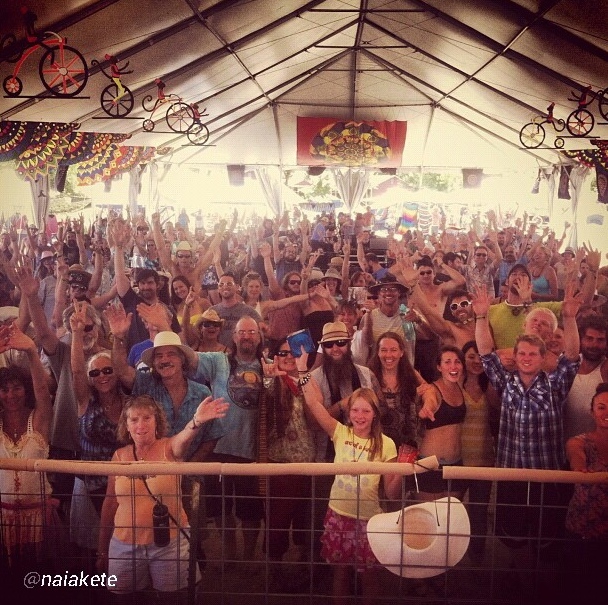 apply. The festival includes side show distractions like yoga on the hour, a kids play area, continuous Frisbee and hula hoops, (go Wham-o!) impromptu jam sessions and a delicious public swimming pool. Incredible alpine hikes are just down the road. And did I mention fifty of the hottest touring acts in the world?
apply. The festival includes side show distractions like yoga on the hour, a kids play area, continuous Frisbee and hula hoops, (go Wham-o!) impromptu jam sessions and a delicious public swimming pool. Incredible alpine hikes are just down the road. And did I mention fifty of the hottest touring acts in the world?
Fellow music aficionado Rob Steinberg has regularly served as my host when I have gigs performing for the Jewish community of New Orleans. Rob is on a self-imposed mission to turn friends on to the best of the music-drenched Crescent City. He rarely leaves town save for this annual Sierra experience and has been mentioning for years that I’ve “got to try it someday.” Well, my excuse materialized in a unusual set of blessings (some might say coincidences.) Firstly, I was invited by Rabbi Yonah Bookstein to help lead the program at their annual High Sierra Shabbat Tentprogram (shabbattent.com is our Tzedakah of the Month below.) The staff provides a welcome refuge from the din and heat with free munchies, ice water, Shabbat meals and prayer services to ANYONE who is in need. July 4th weekend has always meant a pilgrimage to my folk’s home in Pacific Palisades where their shul has a gala BBQ on the parade route followed by beachside fireworks at my old high school. This year, however, my mom is in Israel visiting my brother’s family. My boys are counselors in summer camp in Wisconsin and my wife and daughter made plans to visit my other brother in San Diego. High Sierra here I come!
I flew into Reno, rented a Sonata and motored the hour and a half up to Quincy. I stopped at a market to load up with groceries, mostly breakfast stuff since I would be eating some meals in the Shabbat Tent. I was glad for the USB input in the car stereo that gave me control of my iPhone via the steering wheel controls…too cool! For some reason my phone defaulted into alphabetic mode. How interesting to hear my playlist of 2000 songs in that format rather than by full album. Over six hours of driving and I never made it out of the A’s! Since I have all twenty-four of my own albums in my digital library much of my music was featured in the alphabetical mix, much like an ultra-customized, grin-inducing Pandora station.
Over the course of the drive I must admit that I was both antsy and homesick. I was trying to remind myself why I had just abandoned my family, something I do fairly regularly thanks to my fifty-city tour every year. I was also worried that I had missed important bands (the event had started earlier in the day) and was hoping to set up my camp before nightfall. Thankfully, I found the festival box office lot easily, drove through a vast, dusty field to a helpful volunteer who welcomed me at my car, fastened on my wristband and sent me to park in a remote lot. I then shlepped my stuff to a shuttle stop and watched helplessly as several shuttles passed that were full or going “out of service.” Thankfully one finally arrived that could fit a few of the many people in line and because I was traveling solo I snagged a spot.
I found it disorienting arriving at this party-in-progress, especially since most of the 10,000 guests had already settled in. Just inside the entrance I found the Shabbat Tent and was overjoyed to see familiar faces. Thankfully Rabbi Yonah had already set up my tent in order to save the space. He gave me a hearty hug and a hand getting my stuff to the campsite after I stashed my refrigeratables in his cooler. I had arrived around 7pm and the heat had abated somewhat…now my tent was only 90 degrees inside. I inflated my air mattress, made the bed, unpacked my gear and then escaped the sauna to hear my first artist of the thirty or so that I would eventually audition. Three main venues had cascading schedules to allow rowdy overachievers like me to see nearly everyone on the bill. The Grandstand is a huge, outdoor mega-stage set up in the center of a dirt track speedway with enough space for the whole crowd. Big Meadow is a partially shaded, partially muddy concert space surrounded by the RV camping area. Finally, Vaudeville, my favorite venue, is a more intimate open wall tent and housed the most raucous bands. This tennis court sized space is surrounded by a grassy field on one side and on the other, the tents of a dozen lucky campers that must have run FAST to secure these prime locations. Their “chill” areas are shaded with canopies and tapestries and they abut the concert space so all they have to do is hang out on their lounge chairs.
housed the most raucous bands. This tennis court sized space is surrounded by a grassy field on one side and on the other, the tents of a dozen lucky campers that must have run FAST to secure these prime locations. Their “chill” areas are shaded with canopies and tapestries and they abut the concert space so all they have to do is hang out on their lounge chairs.
The Grandstand headliner that first night was Robert Plant and his new band, the Sensational Space Shifters. I was prepared for a self-indulgent, esoteric rock/bluegrass set but instead Plant rewarded the stoked crowd with AMAZING renditions of Zep songs. I was transfixed at the power that he held in his grasp: he could woo the crowd with a sweet new ballad or create an immediate frenzy with the first measure of a classic standard like Black Dog or Whole Lotta Love. I must admit that in spite of the power of the performance I was not entirely present. I met plenty of considerate people but at one point was rebuffed by a muscle-bound brute that decided no one was going to get closer to the stage than him. Halfway through the set I met some wonderful clothing vendors whose booths lined the perimeter of the field and had abandoned ship to dance to Plant. I bonded deeply and with these new friends and managed to enter a head-space of unity with the sweaty, happy mob. If you can’t beat ’em, join ’em.
After the show my friends walked me back to their booth filled with brilliant handmade batik clothing and I found that the vendors had their own private community as their booths linked in the rear with hammocks, lounge chairs, tie-dyed tapestries, tables, food and drink and everything needed to make this annual four day pilgrimage a pleasure. Clearly these folks were here for more than making a buck. I called Rob Steinberg to check in and see if he wanted to go to any of the late night shows which play nightly from midnight till 4am. I mentioned that I was in someone’s clothing booth and he said, “Oh, Ciara and John?” Another “Large world, well managed” moment! We agreed to meet for the midnight shows and he felt confident he could get me a ticket. The festival itself is $200 for the four days of music, camping and fun. Late night (11:30pm-4:00am) is a $25 bonus price per venue…there are 2 to choose from and both had sold out.
After a bit of hassle we managed to get tickets, largely because I took initiative and stormed the box office to ask for tickets in Rob’s name. Rob was horrified that I cut the 40 person long line but I just did the “look like you know what you’re doing” thing and simply asked if his name was on a list. He lectured me on festival etiquette, not something I wanted or needed to hear; I had already perceived that this gathering was different that other “survival of the fittest” concert experiences. Clearly, brotherhood is the bylaw..but to sit in a line of wishful thinkers for a sold out show? Anyway, we had our “miracle tickets” and jumped around to three amazing bands: Newgrass founders Leftover Salmon and the extraordinary party bands Pimps of Joytime and Orgone.
Several friends asked why I didn’t bring my wife. First of all, none of the venues have chairs. Anywhere. Secondly, your boogers turn black from dust inhalation. It’s 90 degrees and there’s precious little shade and no air conditioning. You get to camp with thousands of other people in close proximity and the bathrooms are a block away. With lines for the stalls. And mosquitoes. Thursday night there was a five-foot space on one side of my tent, allowing me to enter along the dense corridor of tents from the nearby road. By Friday midday, another half dozen tents had filled the aisle…now there was no way to get back to my tent area without shimmying through the forest of ripstop nylon. That first night my queen size air mattress sprang a leak, leaving me a thin yoga mat to cushion my fifty-year-old bones from the uneven ground below. I lay there imagining my wife sharing this yoga mat with me after a day of travel, crowds, heat and inebriated people…better to do this one on my own.
I got to sleep at 4:30am and had the privilege of a private concert right outside my tent at 6am when one of the late night revelers decided to practice his guitar. I tried to get back to sleep with the aid of earplugs but by 7:30 my tent got so hot that I had to flee. I figured that I’d have to take a nap in order to get through the day and still be dancing late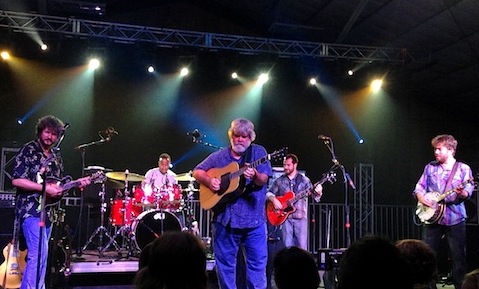 night. But where would I nap? Now I understood why I saw countless people throughout the fairgrounds passed out on the grass, in hammocks, and some, face down in the dust on the edges of the concert venues. Remarkably, no one bothered these people, save for the occasional Samaritan trying to carry them to safety. I realized that one of the crucial elements of this utopian festival is the fact that in spite of arduous conditions, everyone is smiling, peaceful and looking out for one another.
night. But where would I nap? Now I understood why I saw countless people throughout the fairgrounds passed out on the grass, in hammocks, and some, face down in the dust on the edges of the concert venues. Remarkably, no one bothered these people, save for the occasional Samaritan trying to carry them to safety. I realized that one of the crucial elements of this utopian festival is the fact that in spite of arduous conditions, everyone is smiling, peaceful and looking out for one another.
Perhaps I feel so comfortable here because High Sierra is a microcosm of the perfected world paradigm that has motivated the Jewish People for millennia. Of course the peace and harmony is drug induced for many, but the fact is that 10,000 individuals of all faiths, ages and income brackets seem to get along famously. The emphasis is on how much one can share and give rather than the grabby nature of our typical city life. One inter-act MC announced that there are “no strangers” here at High Sierra. The people next to you are just best friends that you haven’t yet met. Some might say that a Shabbat Tent at a “hippie rock festival” is an oxymoron. I think it makes perfect sense.
I searched the fairgrounds for a good place to daven. Certainly there must be an isolated tree and some shade! My efforts proved fruitless in this maze of humanity and I strapped up in the middle of the Vaudeville tent. I believe I was one of only two people wearing a kippah at this festival. The other was Rabbi Yonah who stuck mostly to the confines of the Shabbat Tent, leaving me as the official wandering Jew for the weekend. I lost count of how many people “outed” themselves as members of the tribe. One family of wild-eyed stoners saw me praying that morning and sure enough, the patriarch was a Jewish pot farmer from Northern California. Another woman and her daughter Shaina watched as I shuckled nearby. Shaina had never seen tefillin and had all sorts of questions for me. They live in Oakland and go to a Reform synagogue. She and her family adopted me and became regulars in the Shabbat Tent. If only for connecting with this one family, the whole Shabbat Tent experiment was worth it.
I swapped my tallis bag for my yoga mat and headed out to the main lawn for an hour of Hatha yoga with a hundred new friends. Some didn’t have mats but still participated even though their lithe, sticky bodies were getting covered with dirt. Our transcendent leaders were a Jewish couple from San Francisco that tag-teamed over the course of the vigorous hour-plus workout. I returned to the Shabbas tent for a hearty breakfast of Peanut Butter Cheerios and then dashed off to the first concert of the day. Over the next few hours I crammed in four incredible acts: guitar slinging Scott Pemberton, a vastly innovative player with radical, unorthodox technique, incredible folk/rock party bands The Tumbleweed Wanderers and The Revivalists and then a neophyte up-and-coming band, Houndmouth. Houndmouth is a youthful quartet of “easy on the eye” musicians that were having a tough time winning over the ambivalent crowd. Something switched on during their set. I think the initial bias against these seeming pretty boy (and girl) posers disappeared in the light of their excellent material, great vocals and competent musicianship. I have never seen a band overcome indifference to this degree; by the last several songs the audience was SCREAMING for more.
Houndmouth is a youthful quartet of “easy on the eye” musicians that were having a tough time winning over the ambivalent crowd. Something switched on during their set. I think the initial bias against these seeming pretty boy (and girl) posers disappeared in the light of their excellent material, great vocals and competent musicianship. I have never seen a band overcome indifference to this degree; by the last several songs the audience was SCREAMING for more.
Thankfully Rachel Bookstein had offered to buy me a new air mattress when she was in town shopping for food for Shabbat. After helping her unload a minivan stuffed to the rafters with groceries I pumped up the new bed and then ran for a mikvah at the local public swimming pool a few blocks away. Once again I was faced with a long line of people, this time waiting for the chance to swim. You could only get in when others got out and even though it was already 5pm no one looked like they were ready to leave the coveted H2O. Like every other interaction this weekend, I reframed and relaxed rather than stew in my typical impatient state and therefore had the presence of mind to engage some great people in line, allowing the time fly by. I swam a dozen awkward laps around the crowd, watched divers compete for the most elaborate flip off a diving board contest and then pulled off a discrete mikvah in one of the corners. Perhaps the most unkind moment of the week was when the crowd in the pool started cheering for a heavy-set woman to attempt a cannonball. She did not welcome the attention and was stuck in the spotlight as she jiggled on the diving board.
Following a shower in the pool facility I relished in the feeling of being cleansed of the coating of dust and sunscreen and I returned for services at the Shabbas Tent with a smile on my face. I led a sweet “service” consisting of a series of common denominator Jewish folk songs sung arm in arm. Rabbi Yonah did his best to make everyone feel included and tap into the magic of Shabbat in spite of our cacophonous surroundings. We ate a delicious dinner prepared by Rachel and the JConnect staff while hearing the stories of those individuals who happened upon the tent. Some non-Jews were in attendance and for a few of them it was their first experience with the Jewish Sabbath. Hosting this varied crowd of guests created an uncanny Avraham Avinu ambience. With the tent open on all four sides to all who wanted to enter, we had the opportunity to interface with a diverse and curious self-selected group that in all likelihood would not otherwise be celebrating Shabbat. Just as we finished dinner the nightly parade passed by, pausing at our corner to engage our group in a wild, erotic dance led by Cirque du Soleil-style performers on stilts and an ad hoc twenty piece drum corps. When official candlelighting time arrived I davened a proper Kabbalat Shabbat and Ma’ariv on my own and then headed out to the evening’s festivities.
First I heard a band called White Denim and then on to the headliner Primus whose music was dark and industrial and didn’t seem appropriate for this light-hearted crowd. I left halfway through to check out the very impressive Lord Huron and then snuck backstage with Rob for the John Scofield Uberjam. I’ve never loved Scofield’s sound but in this format with cleverly chosen groovy loops to keep the festival crowd moving, his vast chops were palatable and exciting. Backstage access included the perks of flowing beer and snacks, a true bonus since I was in Shabbat mode. I had to summon deep-reserve energy for late night festivities as Rob scored the elusive tickets yet again and we enjoyed a fantastic set with Fruition and my new favorite bluegrass band, the Infamous Stringdusters. At about 4am there was still a considerable crowd milling about around the concert hall. One of the women that I had met earlier at Shabbat Tent was selling kosher brownies and offered me a few imperfect ones to satisfy my late night munchies. Hard to imagine that I was going to get even less sleep tonight; sure enough there was so much conversation around my tent that I didn’t nod off until 5am.
Morning came early at 7am when the commotion started in the tents around me. I tried to sleep through it but eventually the sun rose to the point where my tent was getting a direct hit, making it immediately uninhabitable. I repeated my davening-yoga-breakfast routine and then enjoyed a long distance Frisbee game with some guys with excellent technique. Hucking the disc with such abandon gave me a CU Boulder déjà vu. Thank God for the eruv! Then on to the Grandstand where I got to jump around to the funky grooves of Moksha and Rubblebucket. Enhancing my pleasure was the fact that both bands had crack horn sections and burning keyboardists. Thanks to my magic wristband I was able to frolic in the front row and have my fill of complimentary drinks and munchies. At one point the Rubblebucket lead singer jumped over the fence and into the pit, dancing with all of us in a frenzy. Then the rest of the horn section followed suit, eventually getting lifted up on people’s shoulders as they continued to play. About ten of us in the front row were welcomed on stage when they returned and we clambered up the enormous subwoofers to dance on stage with the band. Yes, this was an unusual Shabbas!
After a delicious tuna fish, humus and salad lunch back at the Shabbat Tent I schmoozed with several more guests. Some passersby opted to enjoy the quiet and shade and passed out on our beanbag chairs. All good. I met an Alabama-based band called Earth Noodle that was standing at the periphery of the tent wondering what it was all about. I invited them in and fed them and then requested that they sing Amazing Grace with me. For two of them we were the first Jewish people that they had ever met; how cool that their first impression was of such giving, happy people. By now five-year-old Shaina had adopted me as her best buddy and spent the entire time in my lap or daring me to chase her.
The afternoon was filled with more fantastic music and I had to get second and third winds to find the strength to dance. I enjoyed powerful sets by the nonstop monster lineup of the Greyboy Allstars, Barr Brothers and Thievery Corporation and then at 11pm returned to the tent to lead Havdalah. An intimate group gathered as we lit the candle and smelled the spices as I led the songs with my voice and melodica. In attendance was Dave Margulies, one of the founders of the festival, who commented that Shabbat Tent would have a higher profile in the next year’s event. He doled 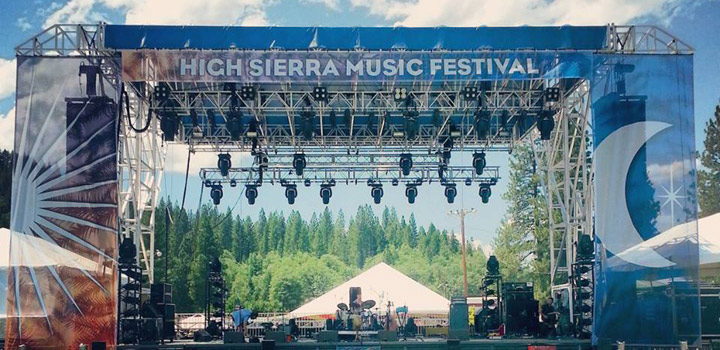 out backstage passes to the Vaudeville tent, allowing the whole Shabbat Tent staff to enjoy the festivities during Lee Field and the Expressions electrifying old-school set. Before I left however, a family that missed Havdalah insisted that I walk with them back to their RV to include the rest of their group. Some high school musicians were leading a full bore jam session in front of their RV next door and it seemed impossible to lead a service amidst the din. I tried another tactic: during a blues number I simply chanted the Havdalah prayer in the form of a blues tune and grooved everyone along to a shavua tov.
out backstage passes to the Vaudeville tent, allowing the whole Shabbat Tent staff to enjoy the festivities during Lee Field and the Expressions electrifying old-school set. Before I left however, a family that missed Havdalah insisted that I walk with them back to their RV to include the rest of their group. Some high school musicians were leading a full bore jam session in front of their RV next door and it seemed impossible to lead a service amidst the din. I tried another tactic: during a blues number I simply chanted the Havdalah prayer in the form of a blues tune and grooved everyone along to a shavua tov.
Late night I met Rob once again for the funk of Jelly Bread the prog rock jamming of Moe. These seasoned musicians put in overtime with dueling guitar solos that were through-composed, with tight as nails breakdowns and a three pronged vocal attack that included their virtuoso bass player. At 3am I walked over to the Mineral Hall where an unlisted acoustic set with Naked Soul was taking place. I am now a die-hard fan of this spiritual, musical foursome. The focus and connection was palpable as all fifty or so late night fans felt blessed to be in the presence of these four gifted artists. I saw some of my Shabbat Tent chevre and we gave each other a look that indicated we were so happy to be part of this experience. Once again I had to force myself to bed in spite of my exhaustion. Just too many good times to be had.
On Sunday I was determined to hit the trail and was ready to miss a few bands to do so. I had printed out the directions before leaving LA to Gold Lake, commonly recommended online as the nicest hike in this region. After breakfast I waited for the shuttle to the remote parking lot and then drove about 15 miles out of town to a rowdy, well-banked dirt road through the pine forest that gained about 2000 feet of elevation. The path terminated at a dusty, neglected campground by the partially drained Silver Lake. I slathered on some sunscreen and started up the beautiful two-mile hike that traversed a ridge with views on either side. There were times when I lost the trail and at one point a poorly marked fork that left me guessing if I had chosen the right path. Finally I spied my destination below, a round, pristine green-blue body of water surrounded by spectacular granite cliffs. There were a few other families there and I schmoozed with one of them as their dog frolicked in and out of the high 70’s crystal clear water. I stripped down to my underwear and dove in, swimming to the center of the lake, floating on my back and staring deeply into the blue sky. When I returned to shore the families were both departing, leaving me along to frolic, sing and do yoga in my birthday suit. True High Sierra splendor.
I drove back to the fairgrounds and this time found a parking spot a few blocks away meaning I wouldn’t have to endure the remote lot and that God-forsaken shuttle. I walked back into the melee of bodies, heat, dust and the pulsating beat, grateful for my morning respite. My first destination was the annual Guitarmageddon jam, a Festival tradition where the top guitarists of the resident bands relish in 80’s hard rock glory. The head banging audience pumped their fists in the air to Stones, Journey and Zeppelin standards. After that I auditioned David Mayfield, Anders Osborne and then another epic set from party band Jelly Bread. By the time I got to reggae heroes Steel Pulse at the Grandstand I was out of gas. Nothing left. I had long since pushed past the second wind mark. One of my neighbors broke out a Emergen-C packet which I downed with a double espresso ice coffee and a pair of Advil. That got me dancing again in the front row for one of the tightest reggae shows I’ve seen. I befriended the hot and exhausted folks behind me who were pressed up against the barrier fence. I took initiative at one point and surprised them with a tray laden with backstage refreshments to slake their thirst. I could see the joy in their eyes as they were revived by the gift and likely poised to pay it forward. Following a great backstage hang with some new friends that were running the festival’s beer concession I ran back to the front row to cheer on Moe, which gave a stellar set that featured many of the luminary sidemen that were on hand.
I sought out my late night buddy Rob but he was back at his apartment with an aching back. Tired as I was I decided to splurge for the Greyboy/Moksha show and was not let down. I danced with all my new friends gathered from a four-day marathon where I met wonderful people at every venue. I found that I remembered everyone’s names, a phenomenon that I can’t always accomplish. I think that it was due to my 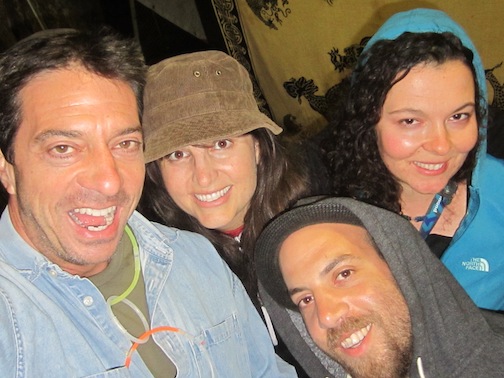 focused efforts in the Shabbat Tent to serve as a light onto nations, spreading a compassionate Jewish presence in this alpine love fest. Just like the connections I make when I lead a Shabbaton weekend and really can “get” everyone that I meet, I feel similarly present in this milieu.
focused efforts in the Shabbat Tent to serve as a light onto nations, spreading a compassionate Jewish presence in this alpine love fest. Just like the connections I make when I lead a Shabbaton weekend and really can “get” everyone that I meet, I feel similarly present in this milieu.
By 4:30am on this last night there were markedly fewer people still awake. I wandered the nearly deserted fairgrounds back to the Shabbat tent where I found Shimon and a few others gathered around a smoldering grill. Shimon had found some meat that wasn’t cooked up on Shabbas and was preparing it for the ride home the next day. I helped him get rid of some perfectly spiced hamburgers, thrilled to have my first taste of meat over the weekend, just when I was ready for a midnight (or mid-morning) snack.
After a few hours of sleep I packed up my gear before the sun got too stifling. I made sure I left my campsite in zero impact condition and shlepped my gear a few blocks to the fairground entrance. After a quick breakfast and earnest goodbyes at the Shabbat Tent I loading up my trusty Hyundai I headed up to Lassen Volcanic National Park. My demeanor had changed fundamentally since the first day of the trip. Now I was suntanned, relaxed and buzzing with the new friendships and musical discoveries. My nearly new rental smoothly negotiated the winding mountain roads where breathtaking vistas unfolded around every corner. A brief hour and a half later and I was at the entrance to this striking high alpine environment for the first time in my life. While it doesn’t compare to Yosemite and Kings Canyon to the south, it is a spectacular destination with unusual hikes and a volatile history. After a film on park history and plate tectonics and discussions with the rangers I left the headquarters for a quick six-hour tour. The ranger told me it would be about a one hour drive through the park and then another two hours back to the Reno airport, plus whatever side trips I took. I crammed in visits to the popular bubbling springs and mud holes of Bumpass Hell (yes, that’s the real name) and a hike to the intimate but spectacular Kings Creek Falls. A sweet 62-year-old recently retired moviemaker accompanied me on one of the hikes and we spent the time talking of exotic travels and photography techniques.
I sensed that I was running a bit late and started to panic each time I was caught behind the occasional motor home on the curvy two-lane road. I could pass at will largely because I didn’t have my wife freaking out in the front seat each time I attempted a daring maneuver. By the time I got to the northern park entrance I had around two hours to make it to the airport and I fretted when I saw that I still had over one hundred fifty miles to drive, much of it on isolated two lane roads. As my iPhone cascaded through all the A’S in my music library I sped through gorgeous Sierra forest and then down into the flats along the 395 to Reno. At the first sign of civilization I stopped to splash water on my face and down a double Frappuccino. With about 42 minutes to go before my flight I pulled up to the airport and left my car at the curb as I sprinted with my suitcase in order to make the 40-minute bag check cutoff. Then I burned rubber out of the airport to a miracle gas station that I found blocks away. Then I hustled back to the rental car return, ran across the driveway with my overweight bags and through security to my gate where I davened a quick mincha and boarded my plane. As the sun set over the golden Sierras our Southwest plane flew down to the lights of LA, returning me to the arms of my deeply understanding wife.
I’m so thankful to Rabbi Yonah, and his staff for their selfless commitment to bringing an “out and proud” Judaism to music festivals across the US. Part of my incentive to write this novel is to thank the backers of Shabbat Tent for giving me the chance to be a big shot and help in the mitzvah of radical hospitality. I’m grateful to Dave Margulies and the other founders for their efforts in nurturing this epic festival. I felt deeply connected with many of the vendors who have made High Sierra their destination for over twenty years and welcomed me into their family. Thanks to Rob Steinberg for over a decade of friendship and for serving as a “courier” in terms of bringing so much quality new music into my life. Finally, thank God for the gift of music, mountains and an adorable, forgiving wife who lets me spread my wings. Hope you can join us next year!
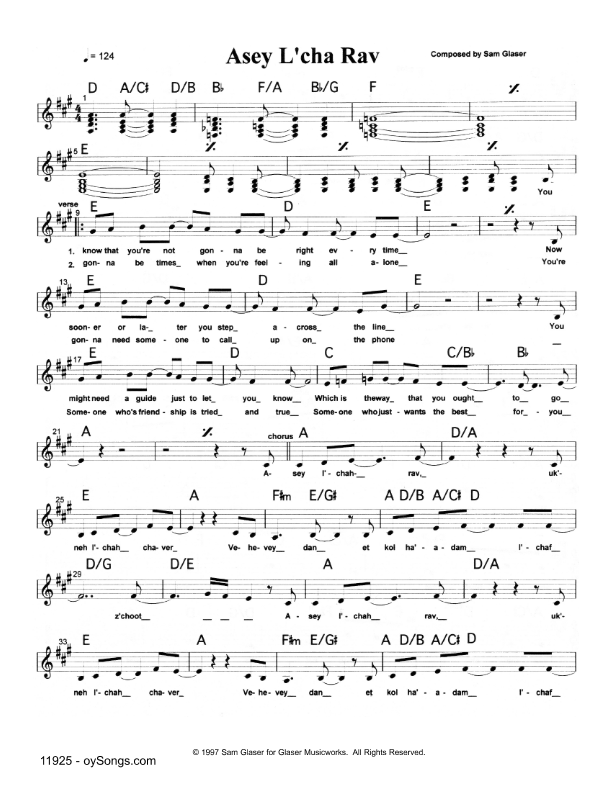 A turning point in the life of any individual that gets serious about his or her Jewish heritage is the moment that they find a rabbi. Everyone needs to have someone they call “my rabbi.” Someone with whom they can relate, someone with whom the buck stops, whose advice they respect and “hold by.” You can blame your rabbi, i.e. “My rabbi told me this is what I have to do,” until you’re ready to initiate your own momentum. The famous line is that “a good rabbi comforts the afflicted and afflicts the comfortable.” At times in your life you will be in either situation, and your rabbi must have the sensitivity to know how to respond in each instance. Effective rabbis gently coax you on a path of growth. They introduce you to mitzvah options and help you choose a direction that is unique for you. Rabbis serve to connect us with our history; they are a link to the written Torah and also embody the oral, less structured Torah that confronts modernity and the idiosyncrasies of the individual.
A turning point in the life of any individual that gets serious about his or her Jewish heritage is the moment that they find a rabbi. Everyone needs to have someone they call “my rabbi.” Someone with whom they can relate, someone with whom the buck stops, whose advice they respect and “hold by.” You can blame your rabbi, i.e. “My rabbi told me this is what I have to do,” until you’re ready to initiate your own momentum. The famous line is that “a good rabbi comforts the afflicted and afflicts the comfortable.” At times in your life you will be in either situation, and your rabbi must have the sensitivity to know how to respond in each instance. Effective rabbis gently coax you on a path of growth. They introduce you to mitzvah options and help you choose a direction that is unique for you. Rabbis serve to connect us with our history; they are a link to the written Torah and also embody the oral, less structured Torah that confronts modernity and the idiosyncrasies of the individual. constituents behind. Rabbis don’t ever get time off. Even when they are enjoying a vacation, the congregation expects them to remain at their beck and call. Rabbis don’t experience the essential weekly release of Shabbat to the same degree as the laity. In fact, the Sabbath and holidays are the times that they are most in demand! Their families tend to be somewhat mutant. After all, rabbis are typically workaholics with precious little time for family matters. Rabbi’s kids are scrutinized only slightly less than their parents. Of course, rabbi’s spouses are criticized if they don’t become part of synagogue life, or conversely if they are too involved. Said spouses often become unpaid employees of the synagogue, like it or not.
constituents behind. Rabbis don’t ever get time off. Even when they are enjoying a vacation, the congregation expects them to remain at their beck and call. Rabbis don’t experience the essential weekly release of Shabbat to the same degree as the laity. In fact, the Sabbath and holidays are the times that they are most in demand! Their families tend to be somewhat mutant. After all, rabbis are typically workaholics with precious little time for family matters. Rabbi’s kids are scrutinized only slightly less than their parents. Of course, rabbi’s spouses are criticized if they don’t become part of synagogue life, or conversely if they are too involved. Said spouses often become unpaid employees of the synagogue, like it or not. interested. I’m writing this essay to beg you to consider getting out of the comfort zone…to take on new challenges and stretch. If your local rabbi is not going to push you into connecting with your Creator via taking on new mitzvot, then that rabbi isn’t for you! That rabbi can still be a friend, a resource, a tennis partner, but it’s not your rabbi. Your rabbi approaches our traditions with joy and makes a relationship with God palpable. Your rabbi makes Jewish living look so good, like a sumptuous banquet! As I’ve said, the book of Jewish law is called the Shulchan Aruch, the set table. An ethical, loving, deeply connected rabbi will inevitably make Judaism so attractive that you can’t help but want some of that for yourself.
interested. I’m writing this essay to beg you to consider getting out of the comfort zone…to take on new challenges and stretch. If your local rabbi is not going to push you into connecting with your Creator via taking on new mitzvot, then that rabbi isn’t for you! That rabbi can still be a friend, a resource, a tennis partner, but it’s not your rabbi. Your rabbi approaches our traditions with joy and makes a relationship with God palpable. Your rabbi makes Jewish living look so good, like a sumptuous banquet! As I’ve said, the book of Jewish law is called the Shulchan Aruch, the set table. An ethical, loving, deeply connected rabbi will inevitably make Judaism so attractive that you can’t help but want some of that for yourself. communal structure. In fact I’ve heard from Conservative leadership that the movement’s failings are due to the consistent shedding of the right wing. In other words, if you get excited about your Judaism and seek daily practice, in most Conservative synagogues (but not all) you will be very lonely. Unfortunately, the rule seems to be that the clergy may be on the “derech” (path) but the congregation for the most part only shows up on High Holidays and for friend’s bar/bat mitzvahs. If you suddenly get interested in keeping kosher you are going to be eating alone. If you want to ramp up your Shabbat observance you will have a hard time relating to the chevra that assembles every week, especially if you are under forty years old. Those with heightened Judaic enthusiasm usually find their way to a Modern Orthodox or Chabad shul and never look back. It’s less an indictment of any given philosophy and more about the astounding impact of a dedicated community. It was the presence of my dynamic learning and chesed (kindness) focused community that made my growth possible. Or at least a lot more fun. I write this with pain in my heart since my Jewish memories are Conservative memories, from amazing summers at Camp Ramah and Israel programs, to Sinai Temple’s dedicated Hebrew School teachers and clergy.
communal structure. In fact I’ve heard from Conservative leadership that the movement’s failings are due to the consistent shedding of the right wing. In other words, if you get excited about your Judaism and seek daily practice, in most Conservative synagogues (but not all) you will be very lonely. Unfortunately, the rule seems to be that the clergy may be on the “derech” (path) but the congregation for the most part only shows up on High Holidays and for friend’s bar/bat mitzvahs. If you suddenly get interested in keeping kosher you are going to be eating alone. If you want to ramp up your Shabbat observance you will have a hard time relating to the chevra that assembles every week, especially if you are under forty years old. Those with heightened Judaic enthusiasm usually find their way to a Modern Orthodox or Chabad shul and never look back. It’s less an indictment of any given philosophy and more about the astounding impact of a dedicated community. It was the presence of my dynamic learning and chesed (kindness) focused community that made my growth possible. Or at least a lot more fun. I write this with pain in my heart since my Jewish memories are Conservative memories, from amazing summers at Camp Ramah and Israel programs, to Sinai Temple’s dedicated Hebrew School teachers and clergy.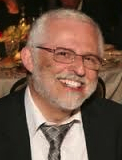 Choosing a rabbi can be the single most important move one makes in initiating a powerful Jewish journey, second only to finding a great spouse. I want to take this moment to thank my amazing rav, Rabbi Moshe Cohen for all the patience, generosity and wisdom that he has shared with my family. Yes, it takes dedication and powerful intention to find your own rabbi. With the guidance of your newfound Jewish “guru” anything is possible for you in your life. Hopefully your own exponential growth will inspire others to attempt the same path, to partake in our perpetual feast from the “set table” of Jewish life. B’hatzlacha on your journey.
Choosing a rabbi can be the single most important move one makes in initiating a powerful Jewish journey, second only to finding a great spouse. I want to take this moment to thank my amazing rav, Rabbi Moshe Cohen for all the patience, generosity and wisdom that he has shared with my family. Yes, it takes dedication and powerful intention to find your own rabbi. With the guidance of your newfound Jewish “guru” anything is possible for you in your life. Hopefully your own exponential growth will inspire others to attempt the same path, to partake in our perpetual feast from the “set table” of Jewish life. B’hatzlacha on your journey.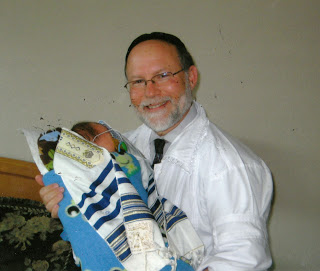 In order for the Jewish People to have a fighting chance at survival we need to connect with nachas. Nachas is the simple feeling of satisfaction when connecting Jewishly. It is a uniquely Jewish sensation and is therefore tough to define for those outside of the tribe. All Jews have had nachas moments. Usually at lifecycle events when we perceive that thanks to this event, all will be well for the Jewish future. Brises, baby-namings, Bar/Bat mitzvahs and Jewish weddings are all nachas moments. Nachas isn’t quite pride, although that’s a big part of it. All parents swell up with pride when a kid has an accomplishment in the world. But a pride moment is an A on an algebra test or passing the Bar Exam. A nachas moment is when that kid can read Hebrew well enough to be called to the Torah. Or when a bride and groom exchange vows under a chuppah. Nachas involves continuity. When the synagogues and federations around the world worry about connecting with the next generation, what they are really saying is that they are concerned about nachas.
In order for the Jewish People to have a fighting chance at survival we need to connect with nachas. Nachas is the simple feeling of satisfaction when connecting Jewishly. It is a uniquely Jewish sensation and is therefore tough to define for those outside of the tribe. All Jews have had nachas moments. Usually at lifecycle events when we perceive that thanks to this event, all will be well for the Jewish future. Brises, baby-namings, Bar/Bat mitzvahs and Jewish weddings are all nachas moments. Nachas isn’t quite pride, although that’s a big part of it. All parents swell up with pride when a kid has an accomplishment in the world. But a pride moment is an A on an algebra test or passing the Bar Exam. A nachas moment is when that kid can read Hebrew well enough to be called to the Torah. Or when a bride and groom exchange vows under a chuppah. Nachas involves continuity. When the synagogues and federations around the world worry about connecting with the next generation, what they are really saying is that they are concerned about nachas.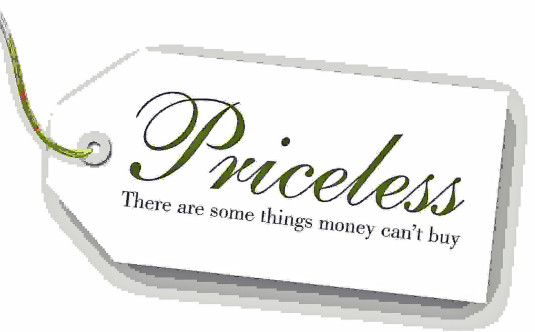 concierge tour of Israel who seemed to have the best of everything. He had recently been divorced from his non-Jewish wife and was rediscovering his roots. I sensed there was an emptiness that he was trying to fill with this short visit to the Holy Land. My rabbi brother turned to me and said, “He has everything except nachas.” Money can’t buy nachas. It’s a human pleasure on a higher plateau, up there with love, power, divine connection. Nachas takes investment, sacrifice and wisdom. In Jewish life, it’s not “he who dies with the most toys wins.” Go to any Jewish funeral; we don’t do roasts or talk about real estate acquisitions. Those properly eulogizing the dead are talking about nachas moments, the impact he or she had on loved ones, acts of charity and loving-kindness.
concierge tour of Israel who seemed to have the best of everything. He had recently been divorced from his non-Jewish wife and was rediscovering his roots. I sensed there was an emptiness that he was trying to fill with this short visit to the Holy Land. My rabbi brother turned to me and said, “He has everything except nachas.” Money can’t buy nachas. It’s a human pleasure on a higher plateau, up there with love, power, divine connection. Nachas takes investment, sacrifice and wisdom. In Jewish life, it’s not “he who dies with the most toys wins.” Go to any Jewish funeral; we don’t do roasts or talk about real estate acquisitions. Those properly eulogizing the dead are talking about nachas moments, the impact he or she had on loved ones, acts of charity and loving-kindness. we make are a small price to pay for the rewards of nurturing Jewishly alive offspring. We’re “paying it forward,” laying the seeds for the future joy of our own kid’s Jewish grandchildren, God willing. Thanks to my prodigious frequent flyer miles we just returned from a two-week family vacation in Israel to visit our oldest son Max who is spending a year learning in yeshiva. He showed up at Ben Gurion airport to pick us up on a Friday afternoon already decked out in his form-fitting Shabbas suit. Clean cut, tanned, in top shape (thanks to the yeshiva gym) and with tzitzit dangling. Can you imagine my slack-jawed, overwhelming rush of nachas?
we make are a small price to pay for the rewards of nurturing Jewishly alive offspring. We’re “paying it forward,” laying the seeds for the future joy of our own kid’s Jewish grandchildren, God willing. Thanks to my prodigious frequent flyer miles we just returned from a two-week family vacation in Israel to visit our oldest son Max who is spending a year learning in yeshiva. He showed up at Ben Gurion airport to pick us up on a Friday afternoon already decked out in his form-fitting Shabbas suit. Clean cut, tanned, in top shape (thanks to the yeshiva gym) and with tzitzit dangling. Can you imagine my slack-jawed, overwhelming rush of nachas? to spiritual Jewish music! In your car, on your ipod, on your couch. There are hundreds of amazing artists out there with songs that will nourish your soul and connect you deeply with your own Jewish journey. Jewish music bolsters feelings of unity with the Jewish People and our Creator. Music can make you sing and dance…it is the antidote to lethargy and hopelessness. In fact, music is often the transport medium of nachas. At my own wedding, one of my friends helped settle my nerves by advising me to sum up all my needs and concerns with one simple prayer under the chuppah: that I be able to give God nachas. May we all have lifecycle events filled with sweet song and abundant nachas. May we all serve God with joy and merit a speedy redemption for our troubled world.
to spiritual Jewish music! In your car, on your ipod, on your couch. There are hundreds of amazing artists out there with songs that will nourish your soul and connect you deeply with your own Jewish journey. Jewish music bolsters feelings of unity with the Jewish People and our Creator. Music can make you sing and dance…it is the antidote to lethargy and hopelessness. In fact, music is often the transport medium of nachas. At my own wedding, one of my friends helped settle my nerves by advising me to sum up all my needs and concerns with one simple prayer under the chuppah: that I be able to give God nachas. May we all have lifecycle events filled with sweet song and abundant nachas. May we all serve God with joy and merit a speedy redemption for our troubled world. I am both a music lover and music maker. I’ve learned that the two are mutually exclusive; I have composer friends that minimize exposure to anyone else’s music in order to avoid being unduly influenced. I, on the other hand, regularly thank God for the gift of listening to music…any kind of music! Particularly when driving in LA traffic jams. I’m a fan of many local, US and international bands and I try to be a good groupie and sit in the front row whenever I can sneak out to their shows. I’m a regular at the LA Phil and LA Opera. I’m obsessed with jazz. I have over 3000 CDs of all genres in my collection and I still have my ear out for new sounds. My wife and I share in the Top 40 fun with our three kids and keep abreast of The Voice, Idol and America’s Got Talent. We admit to being both Beliebers and Gleeks. I used to brag that I like every style of music except Country. Well, thanks to dedicated honky-tonk friends I have been converted to the best of southern pedal steel, hillbilly, bluegrass, gospel and even yodeling.
I am both a music lover and music maker. I’ve learned that the two are mutually exclusive; I have composer friends that minimize exposure to anyone else’s music in order to avoid being unduly influenced. I, on the other hand, regularly thank God for the gift of listening to music…any kind of music! Particularly when driving in LA traffic jams. I’m a fan of many local, US and international bands and I try to be a good groupie and sit in the front row whenever I can sneak out to their shows. I’m a regular at the LA Phil and LA Opera. I’m obsessed with jazz. I have over 3000 CDs of all genres in my collection and I still have my ear out for new sounds. My wife and I share in the Top 40 fun with our three kids and keep abreast of The Voice, Idol and America’s Got Talent. We admit to being both Beliebers and Gleeks. I used to brag that I like every style of music except Country. Well, thanks to dedicated honky-tonk friends I have been converted to the best of southern pedal steel, hillbilly, bluegrass, gospel and even yodeling. apply. The festival includes side show distractions like yoga on the hour, a kids play area, continuous Frisbee and hula hoops, (go Wham-o!) impromptu jam sessions and a delicious public swimming pool. Incredible alpine hikes are just down the road. And did I mention fifty of the hottest touring acts in the world?
apply. The festival includes side show distractions like yoga on the hour, a kids play area, continuous Frisbee and hula hoops, (go Wham-o!) impromptu jam sessions and a delicious public swimming pool. Incredible alpine hikes are just down the road. And did I mention fifty of the hottest touring acts in the world? housed the most raucous bands. This tennis court sized space is surrounded by a grassy field on one side and on the other, the tents of a dozen lucky campers that must have run FAST to secure these prime locations. Their “chill” areas are shaded with canopies and tapestries and they abut the concert space so all they have to do is hang out on their lounge chairs.
housed the most raucous bands. This tennis court sized space is surrounded by a grassy field on one side and on the other, the tents of a dozen lucky campers that must have run FAST to secure these prime locations. Their “chill” areas are shaded with canopies and tapestries and they abut the concert space so all they have to do is hang out on their lounge chairs. night. But where would I nap? Now I understood why I saw countless people throughout the fairgrounds passed out on the grass, in hammocks, and some, face down in the dust on the edges of the concert venues. Remarkably, no one bothered these people, save for the occasional Samaritan trying to carry them to safety. I realized that one of the crucial elements of this utopian festival is the fact that in spite of arduous conditions, everyone is smiling, peaceful and looking out for one another.
night. But where would I nap? Now I understood why I saw countless people throughout the fairgrounds passed out on the grass, in hammocks, and some, face down in the dust on the edges of the concert venues. Remarkably, no one bothered these people, save for the occasional Samaritan trying to carry them to safety. I realized that one of the crucial elements of this utopian festival is the fact that in spite of arduous conditions, everyone is smiling, peaceful and looking out for one another. Houndmouth is a youthful quartet of “easy on the eye” musicians that were having a tough time winning over the ambivalent crowd. Something switched on during their set. I think the initial bias against these seeming pretty boy (and girl) posers disappeared in the light of their excellent material, great vocals and competent musicianship. I have never seen a band overcome indifference to this degree; by the last several songs the audience was SCREAMING for more.
Houndmouth is a youthful quartet of “easy on the eye” musicians that were having a tough time winning over the ambivalent crowd. Something switched on during their set. I think the initial bias against these seeming pretty boy (and girl) posers disappeared in the light of their excellent material, great vocals and competent musicianship. I have never seen a band overcome indifference to this degree; by the last several songs the audience was SCREAMING for more. out backstage passes to the Vaudeville tent, allowing the whole Shabbat Tent staff to enjoy the festivities during Lee Field and the Expressions electrifying old-school set. Before I left however, a family that missed Havdalah insisted that I walk with them back to their RV to include the rest of their group. Some high school musicians were leading a full bore jam session in front of their RV next door and it seemed impossible to lead a service amidst the din. I tried another tactic: during a blues number I simply chanted the Havdalah prayer in the form of a blues tune and grooved everyone along to a shavua tov.
out backstage passes to the Vaudeville tent, allowing the whole Shabbat Tent staff to enjoy the festivities during Lee Field and the Expressions electrifying old-school set. Before I left however, a family that missed Havdalah insisted that I walk with them back to their RV to include the rest of their group. Some high school musicians were leading a full bore jam session in front of their RV next door and it seemed impossible to lead a service amidst the din. I tried another tactic: during a blues number I simply chanted the Havdalah prayer in the form of a blues tune and grooved everyone along to a shavua tov. focused efforts in the Shabbat Tent to serve as a light onto nations, spreading a compassionate Jewish presence in this alpine love fest. Just like the connections I make when I lead a Shabbaton weekend and really can “get” everyone that I meet, I feel similarly present in this milieu.
focused efforts in the Shabbat Tent to serve as a light onto nations, spreading a compassionate Jewish presence in this alpine love fest. Just like the connections I make when I lead a Shabbaton weekend and really can “get” everyone that I meet, I feel similarly present in this milieu.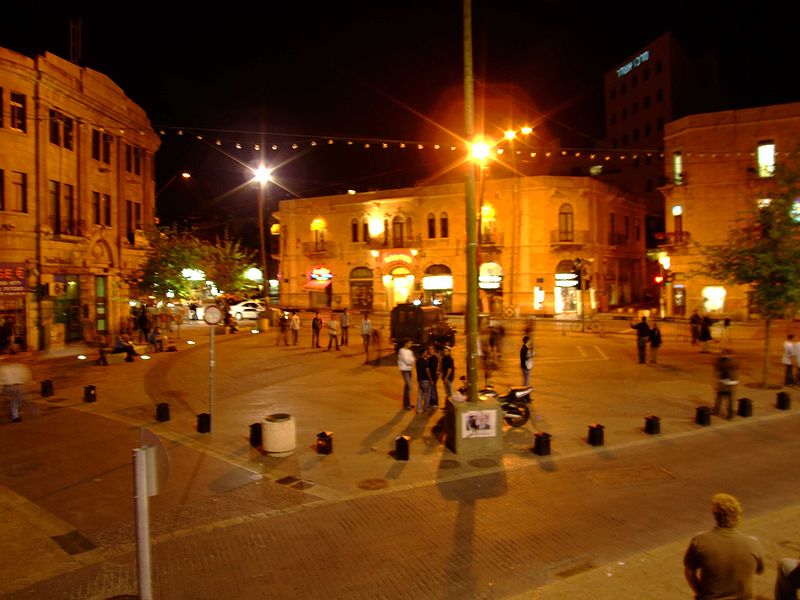 As a teenager I remember the call as I walked down Kikar Tziyon (Zion Square) in Jerusalem. The call of “Mincha, Mincha,” rang out from the entrance of a small storefront shul. I would do my best to avoid the squat elderly man with a thick Sephardic accent that beckoned in the doorway. God forbid I have my afternoon fun interrupted with 10 minutes of boredom as I stood there pretending to pray. As a young traveler I did not have any tradition of the afternoon prayer ritual. At that point in my life I was aware of Shachrit, the morning service which I avoided since I saw it as far too long and inconvenient. I was familiar with Ma’ariv, the evening service from Friday nights at Camp Ramah. But Mincha? No, Mincha was a foreign word to me, lost in the same summertime wasteland that claimed Shavuot, S’firat Ha’Omer and the “Three Weeks.” If it was left out of our annual Hebrew School lexicon it couldn’t be something I needed to worry about.
As a teenager I remember the call as I walked down Kikar Tziyon (Zion Square) in Jerusalem. The call of “Mincha, Mincha,” rang out from the entrance of a small storefront shul. I would do my best to avoid the squat elderly man with a thick Sephardic accent that beckoned in the doorway. God forbid I have my afternoon fun interrupted with 10 minutes of boredom as I stood there pretending to pray. As a young traveler I did not have any tradition of the afternoon prayer ritual. At that point in my life I was aware of Shachrit, the morning service which I avoided since I saw it as far too long and inconvenient. I was familiar with Ma’ariv, the evening service from Friday nights at Camp Ramah. But Mincha? No, Mincha was a foreign word to me, lost in the same summertime wasteland that claimed Shavuot, S’firat Ha’Omer and the “Three Weeks.” If it was left out of our annual Hebrew School lexicon it couldn’t be something I needed to worry about. centerpiece of my day. The first is my limited attention span. I’m a believer in “living by the mitzvot,” in other words, if I feel a certain mitzvah is “killing” me, I feel no remorse in minimizing it. Shachrit takes a long time and when I’m davening on my own, I take liberties with shortening the Pseukei D’zimra (opening prayers of praise,) for example. Mincha fits in this perfect 5-10 minute window of opportunity where I can dive in and then re-enter the workday.
centerpiece of my day. The first is my limited attention span. I’m a believer in “living by the mitzvot,” in other words, if I feel a certain mitzvah is “killing” me, I feel no remorse in minimizing it. Shachrit takes a long time and when I’m davening on my own, I take liberties with shortening the Pseukei D’zimra (opening prayers of praise,) for example. Mincha fits in this perfect 5-10 minute window of opportunity where I can dive in and then re-enter the workday.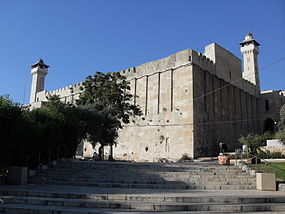 Our thrice daily prayer ritual reflects the contributions of each of our three forefathers. Avraham gave us the custom of Shachrit due to his early morning service reported in the Torah. Yaakov gave us Ma’ariv due to his intense nighttime experience on Har HaMoriah dreaming of ladders stretching up to heaven. We have Yitzchak to thank for Mincha. He is described as “conversing in the field” before the sun set when his besheret Rivka gets a glimpse of him for the first time. Likely this 30-something young man was praying hard for a wife. It’s no wonder that we too are “in the field” when we daven Mincha, either in the agricultural sense toiling the ground by the “sweat of our brow” or in whatever “field” we are engaged.
Our thrice daily prayer ritual reflects the contributions of each of our three forefathers. Avraham gave us the custom of Shachrit due to his early morning service reported in the Torah. Yaakov gave us Ma’ariv due to his intense nighttime experience on Har HaMoriah dreaming of ladders stretching up to heaven. We have Yitzchak to thank for Mincha. He is described as “conversing in the field” before the sun set when his besheret Rivka gets a glimpse of him for the first time. Likely this 30-something young man was praying hard for a wife. It’s no wonder that we too are “in the field” when we daven Mincha, either in the agricultural sense toiling the ground by the “sweat of our brow” or in whatever “field” we are engaged. God satisfies the desire of those with “chai ratzon,” in other words, those who have a will that is alive. So much of our day is often spent in repetitive tasks and drudgery. We take the same way to work every day, eat the same lunch, see the same faces. Our fire is slowly extinguished by the repetition of the “daily grind” and that ennui can soon turn into hopelessness. The idea of this line of the Ashrei is that YOU must take responsibility for keeping your will alive. Only you can change things around. Take a different way to work, get together with old friends, rediscover activities you enjoy, get physical rather than passive in front of a TV screen or a Facebook feed. Being truly alive requires more than just food, water and an occasional jaunt on a treadmill.
God satisfies the desire of those with “chai ratzon,” in other words, those who have a will that is alive. So much of our day is often spent in repetitive tasks and drudgery. We take the same way to work every day, eat the same lunch, see the same faces. Our fire is slowly extinguished by the repetition of the “daily grind” and that ennui can soon turn into hopelessness. The idea of this line of the Ashrei is that YOU must take responsibility for keeping your will alive. Only you can change things around. Take a different way to work, get together with old friends, rediscover activities you enjoy, get physical rather than passive in front of a TV screen or a Facebook feed. Being truly alive requires more than just food, water and an occasional jaunt on a treadmill.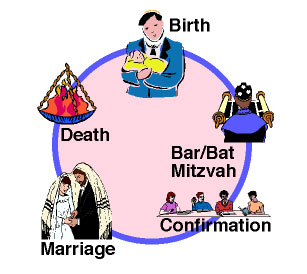 Everybody knows about the famous ones: bris, baby naming, bar/bat mitzvah, marriage and funerals. This month’s column is a segue from last month’s report on the miraculous nature of the bris and is dedicated to certain overlooked milestones that are equally a part of life. All cultures celebrate rites of passage. In the US we have graduations, sweet 16’s, getting a driver’s license, and the holy grail, reaching drinking age. As a parent I’ve noticed that once you have kids there are a few other significant transitions that are rarely discussed.
Everybody knows about the famous ones: bris, baby naming, bar/bat mitzvah, marriage and funerals. This month’s column is a segue from last month’s report on the miraculous nature of the bris and is dedicated to certain overlooked milestones that are equally a part of life. All cultures celebrate rites of passage. In the US we have graduations, sweet 16’s, getting a driver’s license, and the holy grail, reaching drinking age. As a parent I’ve noticed that once you have kids there are a few other significant transitions that are rarely discussed. “reproductively irrelevant.” I always envisioned having four kids. Four is a nice, round number, I grew up in a family with four boys and I felt like four meant you were a real parent. Also, one of our favorite rebbetzins used to lecture us on the importance of Jews having large families to undo the damage of Hitler’s taking 1.5 Million of our kinderlach. I love the sweet adventure and mystery of pregnancy and birth. Of course that’s easy for me to say. I tried to participate in everything, from birth coaching to feeding and the changing diapers. I even got to dispense the milk my wife would laboriously pump.
“reproductively irrelevant.” I always envisioned having four kids. Four is a nice, round number, I grew up in a family with four boys and I felt like four meant you were a real parent. Also, one of our favorite rebbetzins used to lecture us on the importance of Jews having large families to undo the damage of Hitler’s taking 1.5 Million of our kinderlach. I love the sweet adventure and mystery of pregnancy and birth. Of course that’s easy for me to say. I tried to participate in everything, from birth coaching to feeding and the changing diapers. I even got to dispense the milk my wife would laboriously pump. The next lifecycle event came on the heels of our last child becoming a Bat Mitzvah. Sarah turning 12 means that Max is a senior in high school. Yes, my friends, the empty nest phase is approaching. We are now in the midst of SAT’s, college applications and researching yeshivot in Israel. Last month he went on his senior trip in which the class goes to Israel to see firsthand the top fifteen academies that are recommended for their gap year of study. This is all very exciting for Max. But it’s a bit heartbreaking for me. Our official annual vacation this last January was our last as a whole family, at least for the foreseeable future. Next year he won’t be with us for Pesach. Or High Holidays or Chanukah for that matter. We won’t enjoy his brief appearance at dinner every night. And Jesse, who is only a year-and-a-half younger soon will be following in his footsteps. I’m getting weepy writing this. I know I should be stoic and matter of fact. But I will leave that for my wife, who wears the pants in the family. (Actually I wear the pants, but she tells me which pair.)
The next lifecycle event came on the heels of our last child becoming a Bat Mitzvah. Sarah turning 12 means that Max is a senior in high school. Yes, my friends, the empty nest phase is approaching. We are now in the midst of SAT’s, college applications and researching yeshivot in Israel. Last month he went on his senior trip in which the class goes to Israel to see firsthand the top fifteen academies that are recommended for their gap year of study. This is all very exciting for Max. But it’s a bit heartbreaking for me. Our official annual vacation this last January was our last as a whole family, at least for the foreseeable future. Next year he won’t be with us for Pesach. Or High Holidays or Chanukah for that matter. We won’t enjoy his brief appearance at dinner every night. And Jesse, who is only a year-and-a-half younger soon will be following in his footsteps. I’m getting weepy writing this. I know I should be stoic and matter of fact. But I will leave that for my wife, who wears the pants in the family. (Actually I wear the pants, but she tells me which pair.)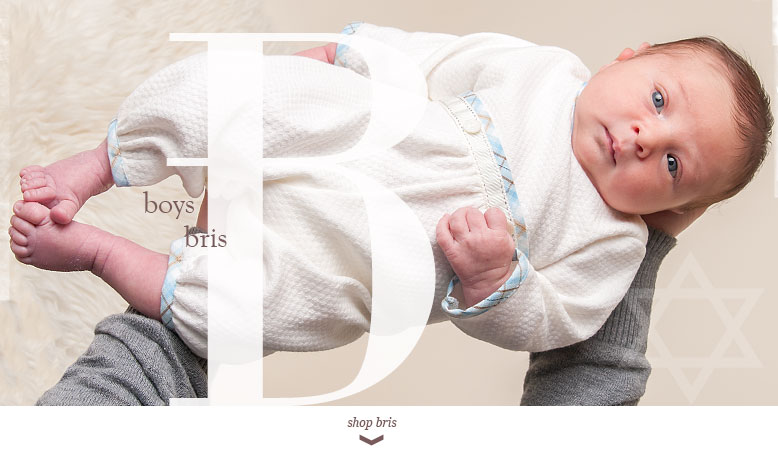 What did the moel bring to the bris?
What did the moel bring to the bris?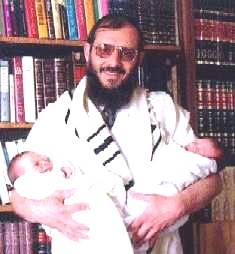 Two days later came the fancy bris of the month. All of the neighborhood big shots were assembled and it was anyone’s guess which bearded sage would be graced with the highest honor of sandek, the person who holds the baby in his lap during the ceremony. It was the father’s fourth child but he was as touched as if it were his first. His beautiful wife sobbed as she looked on. Amidst the pomp and circumstance of this first class affair there was still a simple presence of the Shechina and sure enough I found myself getting misty eyed once again. I was still wearing my tallis and tefillin from Shachrit and even though I had prayed in rote fashion, the power of the words I had already uttered somehow landed in my atria at the moment of the incision. One lesson learned: most attendees come for the mitzvah and not the meal. The ample delicacies were artfully displayed in stations across the vaulted lobby of the Museum of Tolerance and yet about 10% was eaten by the time the room cleared out.
Two days later came the fancy bris of the month. All of the neighborhood big shots were assembled and it was anyone’s guess which bearded sage would be graced with the highest honor of sandek, the person who holds the baby in his lap during the ceremony. It was the father’s fourth child but he was as touched as if it were his first. His beautiful wife sobbed as she looked on. Amidst the pomp and circumstance of this first class affair there was still a simple presence of the Shechina and sure enough I found myself getting misty eyed once again. I was still wearing my tallis and tefillin from Shachrit and even though I had prayed in rote fashion, the power of the words I had already uttered somehow landed in my atria at the moment of the incision. One lesson learned: most attendees come for the mitzvah and not the meal. The ample delicacies were artfully displayed in stations across the vaulted lobby of the Museum of Tolerance and yet about 10% was eaten by the time the room cleared out. There is special significance in the fact that we are commanded to carry out this holy procedure on the eighth day. Kabbalah teaches that seven is the number associated with the intersection of the human sphere and the divine. That is why our weekly communion with our Creator and Redeemer, the Sabbath, is every seventh day. Eight is one step beyond, entirely metaphysical, the realm of the supernatural. It is interesting that eight is simply the vertical representation of the universal symbol for infinity. Eight is also the number associated with Chanukah where we celebrate the miraculous victory of the Maccabees and the length of time that the single cruse of oil burned. Some say that the miracle of Chanukah is the fact that we bothered to try to light the menorah or fight the Syrian-Greeks in the first place. After all, isn’t it wiser to surrender when all the chips are down, when defeat is inevitable? NO, says Jewish tradition. That is precisely when we must remember that we are a supernatural people that defies all laws of conventional sociology and, with God’s help, we are invincible.
There is special significance in the fact that we are commanded to carry out this holy procedure on the eighth day. Kabbalah teaches that seven is the number associated with the intersection of the human sphere and the divine. That is why our weekly communion with our Creator and Redeemer, the Sabbath, is every seventh day. Eight is one step beyond, entirely metaphysical, the realm of the supernatural. It is interesting that eight is simply the vertical representation of the universal symbol for infinity. Eight is also the number associated with Chanukah where we celebrate the miraculous victory of the Maccabees and the length of time that the single cruse of oil burned. Some say that the miracle of Chanukah is the fact that we bothered to try to light the menorah or fight the Syrian-Greeks in the first place. After all, isn’t it wiser to surrender when all the chips are down, when defeat is inevitable? NO, says Jewish tradition. That is precisely when we must remember that we are a supernatural people that defies all laws of conventional sociology and, with God’s help, we are invincible. My wife buys the smallest packages of food in order to conserve space in our three-shelf pantry. When I open it on any given morning and find one of those 10oz. boxes of Cheerios I cringe and dream of a time when we can shop at Costco. Furthermore, I insist on having a plethora of cereal options so that I can mix and match my breakfast. She retaliates by buying the mini jars of peanut butter. I get the same grief when it comes to my closet full of clothes. She argues that I have more than she does and calls me a pack rat. I respond that I like lots of choices and see no reason to throw my old favorites away, as long as they still fit. So too with my CD collection, the gear in my music studio, my library. Am I too attached to material things? Yes. But I prefer to give my obsession another name.
My wife buys the smallest packages of food in order to conserve space in our three-shelf pantry. When I open it on any given morning and find one of those 10oz. boxes of Cheerios I cringe and dream of a time when we can shop at Costco. Furthermore, I insist on having a plethora of cereal options so that I can mix and match my breakfast. She retaliates by buying the mini jars of peanut butter. I get the same grief when it comes to my closet full of clothes. She argues that I have more than she does and calls me a pack rat. I respond that I like lots of choices and see no reason to throw my old favorites away, as long as they still fit. So too with my CD collection, the gear in my music studio, my library. Am I too attached to material things? Yes. But I prefer to give my obsession another name. correctness. We live at a time when conscientious Americans are trying to reduce our carbon footprints, bringing canvas bags to the supermarket, driving hybrids and recycling. I’m not suggesting that we abandon these astute practices, God forbid! I am suggesting that we distinguish between minimizing our consumption and maximizing our joy.
correctness. We live at a time when conscientious Americans are trying to reduce our carbon footprints, bringing canvas bags to the supermarket, driving hybrids and recycling. I’m not suggesting that we abandon these astute practices, God forbid! I am suggesting that we distinguish between minimizing our consumption and maximizing our joy. “magnets”; if we prove that we know how to do the right thing in any situation, clearly God can trust us with abundance. God aches to give us more, but we have to CHOOSE the relationship, we have to ASK for what we want and we have to BUILD ourselves into individuals who can handle abundance.
“magnets”; if we prove that we know how to do the right thing in any situation, clearly God can trust us with abundance. God aches to give us more, but we have to CHOOSE the relationship, we have to ASK for what we want and we have to BUILD ourselves into individuals who can handle abundance. and should use our Jewish institutions to enhance our connection rather than provide a glass ceiling to our growth. My friend David Suissa comments that in religious life we decide, “that’s not what I do” and then defend that stance religiously! We argue: why try a mitzvah one time if it makes us a “hypocrite” for not sticking with it? As Jews, our access to shefa is closely aligned with the mitzvot that we take on. Take a chance! Be a hypocrite once in a while. Suissa quotes Rabbi Shlomo Schwartz as saying “God counts only the mitzvahs you do, not the ones you don’t.”
and should use our Jewish institutions to enhance our connection rather than provide a glass ceiling to our growth. My friend David Suissa comments that in religious life we decide, “that’s not what I do” and then defend that stance religiously! We argue: why try a mitzvah one time if it makes us a “hypocrite” for not sticking with it? As Jews, our access to shefa is closely aligned with the mitzvot that we take on. Take a chance! Be a hypocrite once in a while. Suissa quotes Rabbi Shlomo Schwartz as saying “God counts only the mitzvahs you do, not the ones you don’t.”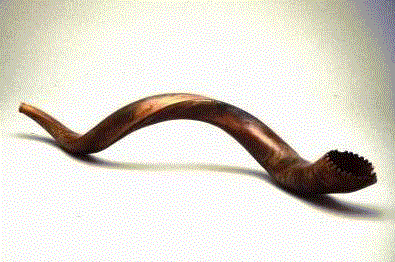 I just returned from my distant cousin Gene Samson’s funeral. I must admit I left my home this morning a bit frustrated that I was going to “lose” half my day and had to wear a black suit on a 90 degree LA scorcher. But as soon as I entered the mortuary I was immediately uplifted by the faces of my extended family and felt the soul-satisfaction of performing the ancient and powerful mitzvah of participating in the burial of a loved one.
I just returned from my distant cousin Gene Samson’s funeral. I must admit I left my home this morning a bit frustrated that I was going to “lose” half my day and had to wear a black suit on a 90 degree LA scorcher. But as soon as I entered the mortuary I was immediately uplifted by the faces of my extended family and felt the soul-satisfaction of performing the ancient and powerful mitzvah of participating in the burial of a loved one.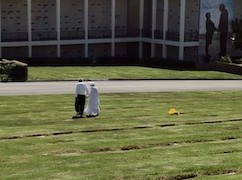 couple married for over 50 years, wearing white, exploring the verdant burial ground of our extended family. I got to cry simply because I love my parents so much, because I miss the relatives that have left us, because I’m human and have a God-given need to open my heart and just have a “good cry.”
couple married for over 50 years, wearing white, exploring the verdant burial ground of our extended family. I got to cry simply because I love my parents so much, because I miss the relatives that have left us, because I’m human and have a God-given need to open my heart and just have a “good cry.” Isaac says “Hineni,” (here I am) and seems to be complicit in his own demise. Avraham is asked to destroy everything he has worked for. The midrash tells us that the angels were crying tears of disbelief and awe at the commitment of our patriarchs and that these tears fell into Isaac’s eyes and led to his blindness. These angelic tears are the tears of injury, tears that are real and damaging and stay with us forever. We have all experienced crises, trauma and tragedy. The question is if we let the damage sabotage us or if we rise from the ashes stronger and more deeply connected to our Creator.
Isaac says “Hineni,” (here I am) and seems to be complicit in his own demise. Avraham is asked to destroy everything he has worked for. The midrash tells us that the angels were crying tears of disbelief and awe at the commitment of our patriarchs and that these tears fell into Isaac’s eyes and led to his blindness. These angelic tears are the tears of injury, tears that are real and damaging and stay with us forever. We have all experienced crises, trauma and tragedy. The question is if we let the damage sabotage us or if we rise from the ashes stronger and more deeply connected to our Creator.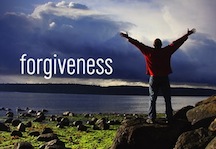 alone. This is the time to make a written accounting of who we are, who we want to be, who we’ve wronged and need to ask for forgiveness. Only when we are at peace with our friends and relatives and in touch with our personal mission can we let the cries of the shofar enter our hearts and tear down the walls of complacency.
alone. This is the time to make a written accounting of who we are, who we want to be, who we’ve wronged and need to ask for forgiveness. Only when we are at peace with our friends and relatives and in touch with our personal mission can we let the cries of the shofar enter our hearts and tear down the walls of complacency. is completely open and there is no one imposing deadlines except you. Being a self-employed musician is even harder. The craft is vastly time consuming, goals are difficult to quantify, and the quality of the final product is entirely subjective and resides in the ether. Most of my peers survive from gig to gig, no grand schemes or business plans. All of my kids are becoming musicians in their own right and while I am gushing with pride at their accomplishments, I am not pushing them into the field as a profession. It’s so easy to flake, to get distracted, to start projects and never finish. If by some miracle you manage to get that masterpiece shrink-wrapped, you then have to put on the businessman’s hat to bring your product to market. Musicians don’t like switching hats; they feel it isn’t part of the job description.
is completely open and there is no one imposing deadlines except you. Being a self-employed musician is even harder. The craft is vastly time consuming, goals are difficult to quantify, and the quality of the final product is entirely subjective and resides in the ether. Most of my peers survive from gig to gig, no grand schemes or business plans. All of my kids are becoming musicians in their own right and while I am gushing with pride at their accomplishments, I am not pushing them into the field as a profession. It’s so easy to flake, to get distracted, to start projects and never finish. If by some miracle you manage to get that masterpiece shrink-wrapped, you then have to put on the businessman’s hat to bring your product to market. Musicians don’t like switching hats; they feel it isn’t part of the job description.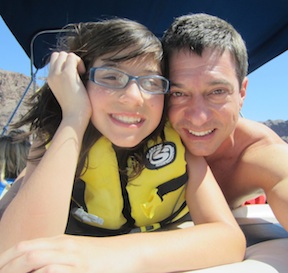 attention save for the furtive glance at his iPhone every few seconds in case a text has arrived. Jesse is a joy to behold unless he’s on headphones mid-battle in his World of Warcraft universe. Sarah plays Mindjolt and Super Mario via Facebook while watching the Food Channel on YouTube. Did I mention we don’t have a TV? We don’t! But everyone has a computer (for homework, of course.) When I get a word in about the importance of self-mastery or using time wisely, I get that look that tells me “you are the ultimate curmudgeon on the planet!” I feel like I’m in a desperate race against the clock to get my kids to appreciate and use their free will wisely while they are still living in my home.
attention save for the furtive glance at his iPhone every few seconds in case a text has arrived. Jesse is a joy to behold unless he’s on headphones mid-battle in his World of Warcraft universe. Sarah plays Mindjolt and Super Mario via Facebook while watching the Food Channel on YouTube. Did I mention we don’t have a TV? We don’t! But everyone has a computer (for homework, of course.) When I get a word in about the importance of self-mastery or using time wisely, I get that look that tells me “you are the ultimate curmudgeon on the planet!” I feel like I’m in a desperate race against the clock to get my kids to appreciate and use their free will wisely while they are still living in my home.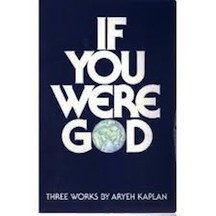 best in his unconventional description of hell in “If You Were God.” According to our sages, we are constantly being measured on how we are maximizing our potential. We are not judged against our peers. Instead, at the end of 120 years, we face the distinction between our potential and actual selves. The degree of difference between them is a source of tremendous humiliation, the “fires of hell,” if you will. Were you the best you that you could be? By maximizing “choose life” moments, we have a better chance of finishing the game in alignment with our greatest potential. According to author Leo Buscaglia, “Who you are is God’s gift to you, who you become is your gift to God.”
best in his unconventional description of hell in “If You Were God.” According to our sages, we are constantly being measured on how we are maximizing our potential. We are not judged against our peers. Instead, at the end of 120 years, we face the distinction between our potential and actual selves. The degree of difference between them is a source of tremendous humiliation, the “fires of hell,” if you will. Were you the best you that you could be? By maximizing “choose life” moments, we have a better chance of finishing the game in alignment with our greatest potential. According to author Leo Buscaglia, “Who you are is God’s gift to you, who you become is your gift to God.” So what are we going to do with the kids this summer? Well, for starters, the ultimate Jewish pride builder: a month at Jewish summer camp. The rest of the time we’ll try to keep them away from screens as much as possible. Yes, we have to intervene…for most kids, time management is bigger than them. We will use the remaining six weeks to nurture existing hobbies and jumpstart new ones. Double up on instrument lessons, lots of Krav Maga, a filmmaking workshop. I am taking my oldest son into the wilderness for a week and will take lots of pictures so that he can look back and see that his old man cared enough to do something about it rather than just complain. And yes, we’ll see some 3D movies, visit the waterslides and go to Ben and Jerry’s. We may be strict but we’re not crazy.
So what are we going to do with the kids this summer? Well, for starters, the ultimate Jewish pride builder: a month at Jewish summer camp. The rest of the time we’ll try to keep them away from screens as much as possible. Yes, we have to intervene…for most kids, time management is bigger than them. We will use the remaining six weeks to nurture existing hobbies and jumpstart new ones. Double up on instrument lessons, lots of Krav Maga, a filmmaking workshop. I am taking my oldest son into the wilderness for a week and will take lots of pictures so that he can look back and see that his old man cared enough to do something about it rather than just complain. And yes, we’ll see some 3D movies, visit the waterslides and go to Ben and Jerry’s. We may be strict but we’re not crazy. This Rosh Chodesh Nissan I had the pleasure of culminating my eight-day tour of Florida with a Shabbaton in Cooper City, just north of Miami. Just before launching into Kabbalat Shabbat services I sang Auld Lang Syne. After all, we just concluded Adar, the final month of year in terms of the biblical count. That makes the transition into Nissan the true New Year’s Eve. As soon as the moon is full, on the eve of the fifteenth night of the first month, we celebrate our annual birthday as a nation. Some 3000 years ago we were a nation enslaved by a decadent tyrant, yearning for freedom. At the stroke of midnight that first Passover, after nine months of plagues, we emerged from the womb of Egypt to our destiny of freedom. The concealment of Adar gives way to open revelation at the Sea of Reeds and Sinai, and thanks to our remarkable custom of making an annual Seder, we still relish in the birth of the unbreakable soul of our nation.
This Rosh Chodesh Nissan I had the pleasure of culminating my eight-day tour of Florida with a Shabbaton in Cooper City, just north of Miami. Just before launching into Kabbalat Shabbat services I sang Auld Lang Syne. After all, we just concluded Adar, the final month of year in terms of the biblical count. That makes the transition into Nissan the true New Year’s Eve. As soon as the moon is full, on the eve of the fifteenth night of the first month, we celebrate our annual birthday as a nation. Some 3000 years ago we were a nation enslaved by a decadent tyrant, yearning for freedom. At the stroke of midnight that first Passover, after nine months of plagues, we emerged from the womb of Egypt to our destiny of freedom. The concealment of Adar gives way to open revelation at the Sea of Reeds and Sinai, and thanks to our remarkable custom of making an annual Seder, we still relish in the birth of the unbreakable soul of our nation.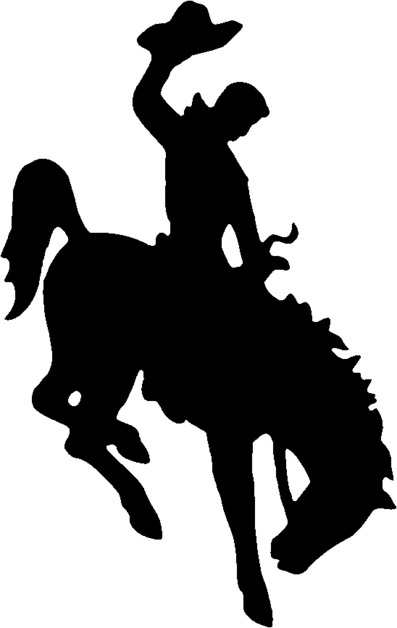 insists that this body is no more than a meat-jacket that we must maintain with food, water and exercise so that it can continue to shlep the precious, divine soul on it’s mission. Throughout the year we indulge in petty material concerns and accumulations. Come Pesach, along with our physical spring-cleaning we have the opportunity to get down to the soul level in our worldview and interpersonal connections. Kabbalah has given us a window into the soul that is a perfect user manual that engenders pride in ownership. For those empirical types that must see it to believe it, our tradition teaches a “five levels of the soul paradigm” that clarifies the outlines of the ephemeral self. In the interest of having a wide-eyed, openhearted Pesach, allow me to take you through the journey of these five levels, based on the teachings of Rabbi David Aaron and Rabbi Tom Meyer.
insists that this body is no more than a meat-jacket that we must maintain with food, water and exercise so that it can continue to shlep the precious, divine soul on it’s mission. Throughout the year we indulge in petty material concerns and accumulations. Come Pesach, along with our physical spring-cleaning we have the opportunity to get down to the soul level in our worldview and interpersonal connections. Kabbalah has given us a window into the soul that is a perfect user manual that engenders pride in ownership. For those empirical types that must see it to believe it, our tradition teaches a “five levels of the soul paradigm” that clarifies the outlines of the ephemeral self. In the interest of having a wide-eyed, openhearted Pesach, allow me to take you through the journey of these five levels, based on the teachings of Rabbi David Aaron and Rabbi Tom Meyer. during the Holocaust was meaningless manual labor. Without meaning, our lives become living agony. Also, the nefesh is being expressed when we hear the voice of the conscience speaking, that fundamental, cross-cultural concept of good and evil. We know it’s inherently wrong to punch an elderly stranger in the street. Hollywood movies with heroes and villains sell worldwide because all humans share certain internal ethics. That’s our nefesh speaking. Darwinian evolutionists and physicists can’t quite explain why it’s there. But it is. And we know its voice like we know we have five fingers on our hand.
during the Holocaust was meaningless manual labor. Without meaning, our lives become living agony. Also, the nefesh is being expressed when we hear the voice of the conscience speaking, that fundamental, cross-cultural concept of good and evil. We know it’s inherently wrong to punch an elderly stranger in the street. Hollywood movies with heroes and villains sell worldwide because all humans share certain internal ethics. That’s our nefesh speaking. Darwinian evolutionists and physicists can’t quite explain why it’s there. But it is. And we know its voice like we know we have five fingers on our hand. unique, in spite of the fact that we are one among billions of similarly entitled beings. It’s our neshama speaking when we pursue happiness. I’m sure scientists might have convincing theories about why we strive to feel in sync, on a mission, why we feel we are deserving of happiness. But any true pleasure seeker does not need science to explain this universal drive. When we stop to think about it, it’s clear we have a neshama, a divine force informing our every motivation.
unique, in spite of the fact that we are one among billions of similarly entitled beings. It’s our neshama speaking when we pursue happiness. I’m sure scientists might have convincing theories about why we strive to feel in sync, on a mission, why we feel we are deserving of happiness. But any true pleasure seeker does not need science to explain this universal drive. When we stop to think about it, it’s clear we have a neshama, a divine force informing our every motivation.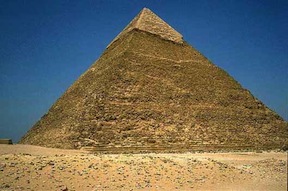 idea of being separate, alone with another. The yichud room at a traditional Jewish wedding is when the bride and groom are secluded in an intimate space just after the ceremony. We’ve all felt yechida: those times when we are deeply connected and empowered and totally blown away. For some of us, it was the birth of our child. For others, a perfect ski run on the back bowls of Vail. Some find it in Yosemite or surfing a glassy, overhead, bowling wave. Ask anyone who feels they were saved from a potential harrowing accident by a miracle. The Seder is a fifteen-step opportunity to spend an entire night in yechida. We say the Sh’ma twice a day to remind ourselves of the possibility, just for that moment, to love God with all our heart, soul and might.
idea of being separate, alone with another. The yichud room at a traditional Jewish wedding is when the bride and groom are secluded in an intimate space just after the ceremony. We’ve all felt yechida: those times when we are deeply connected and empowered and totally blown away. For some of us, it was the birth of our child. For others, a perfect ski run on the back bowls of Vail. Some find it in Yosemite or surfing a glassy, overhead, bowling wave. Ask anyone who feels they were saved from a potential harrowing accident by a miracle. The Seder is a fifteen-step opportunity to spend an entire night in yechida. We say the Sh’ma twice a day to remind ourselves of the possibility, just for that moment, to love God with all our heart, soul and might.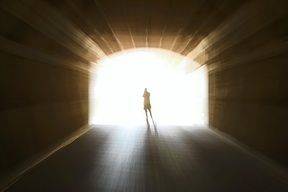 field, Raymond Moody, interviewed thousands of individuals that “flat-lined” for over twenty minutes and then came back to life. Many report a multi-stage chain of events that parallel the description of death in Kabbalah. Commonly experienced phenomena are seeing their body from above, hearing everything that was going on and enduring a rapid review of their lives (much like the great James Brooks movie Defending Your Life.) Some are met by loved ones and are then sent back or feel they must return to their corporeal existence to complete a task. Nearly all see or feel a powerful light that is loving and comforting. Our rabbis tell us that this is the “ziv hashechina,” the light of God, of creation. After all, the sun wasn’t formed until the fourth day…could this be the light that God stated was “good” on the first?
field, Raymond Moody, interviewed thousands of individuals that “flat-lined” for over twenty minutes and then came back to life. Many report a multi-stage chain of events that parallel the description of death in Kabbalah. Commonly experienced phenomena are seeing their body from above, hearing everything that was going on and enduring a rapid review of their lives (much like the great James Brooks movie Defending Your Life.) Some are met by loved ones and are then sent back or feel they must return to their corporeal existence to complete a task. Nearly all see or feel a powerful light that is loving and comforting. Our rabbis tell us that this is the “ziv hashechina,” the light of God, of creation. After all, the sun wasn’t formed until the fourth day…could this be the light that God stated was “good” on the first?